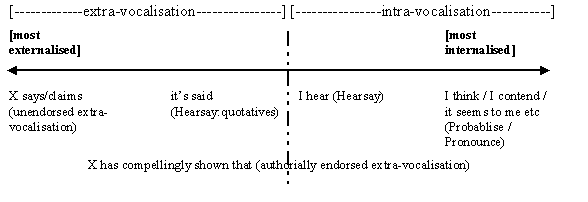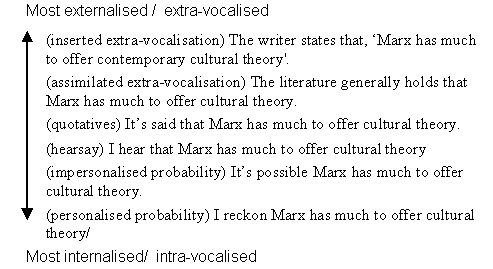


The second parameter by which terms of arguability can be varied turns on the distinction between what I previously termed extra-vocalisation (externalisation) and and intra-vocalisation (internalisation). Under extra-vocalisation, responsibility for the arguability of the proposition/proposition is assigned to some external voice, typically some attributed source. This contrasts with internalising options (intra-vocalisation) where responsibility for arguability is text internal - it remains with the internal authorial voice. This distinction has been very widely examined in the literature in the context of, for example, considerations of the functionality of reported speech and of intertextuality/heteroglossia. In this regard, Hunston, for example, distinguishes between attribution (externalisation/extra-vocaliation) and averal (internalisation/intra-vocalisation). (Hunston 2000) For the most part this a relatively straightforward distinction between material which the authorial voice offers on its own behalf ( This is probably a bad idea / This seems a bad idea. / I hold this to be an undeniably bad idea etc) and material which is attributed to an outside source (e.g. Larry has indicated that he sees this as a bad idea.)
In such clear-cut cases (for example, Some of the agents see this is a bad idea [externalised] versus I think this is a bad idea [internalised]), the difference in arguability and dialogistic positioning is straightforward. As already indicated, this type of externalisation maximally expands the scope for dialogistic negotiation by introducing an additional, external voice to whom the writer/speaker assigns responsibility for the proposition/proposal.
But as has also been indicated above, the distinction and the resultant rhetorical consequences are not always so clear cut. Thus in instances of authorially-endorsed extra-vocalisation (e.g. Larry has compellingly demonstrated that this is a bad idea.), the utterance can be seen as both extra and intra vocalised - it contains both externalising aspects (the attribution to a quoted source) and internalising aspects (the indication that the authorial voice endorses the proposition/proposal). Such formulations can thus bee seen as dialogistically multiple, so to speak - combining both extra-vocalisation and intra-vocalisation so that responsibility for the arguability of the proposition/proposal is ascribed to both the inner and the outer voice .
Values of Hearsay (e.g. it's said.../ I hear...) share this multiple functionality to some degree. On the face of it, Hearsay formulations introduce an external, heteroglossic voice. And yet the fact that the speaker/writer declines to specify or identify the source of the externalised material indicates that they to some degree endorse the proposition/proposal there conveyed - they share some communicative responsibility for the proposition/proposal. The `I hear' formulation takes this one step further by grammatically internalising the extra-vocalisation. However, while authorially endorsed extra-vocalisations combine voices, Hearsay values tend more towards dialogistic ambiguity. The situation remains unclear as to whether responsibility for the utterance lies with the inner or outer voice.
The relationship of various Engagement options to externalisation/internalisation is represented diagrammatically below.

This extra/intra distinction also operates more narrowly (at a level of greater delicacy) to distinguish between options within subsystems. Consider for example the difference in arguability terms between `it seems to me' and `it seems' - both terms within Probabilise:Evidence. The first (it seems to me) is maximally internalised. The `seeming' upon which the arguability of the utterance relies is unambiguously and solely associated with the authorial subjectivity. This is not so absolutely the case with `it seems'. In such a formulation the `seeming' is less clearly specified, it is more generalised or objectified - the `seeming' is not just a matter of inferences drawn by the speaker/writer but, presumably or possibly, by the reader/listener or by the relevant speech community generally. Thus `it seems' - at least when contrasted with `it seems to me' - invokes at least some sense of `externalisation'. It references a dialogistic position which is to some degree separate and hence external from that of the speaker/writer. The same distinction can be seen to underlie the different rhetorical functionality of such pairs as `I think' and `It's probable'. Under the systemic functional framework, such formulations are seen as `grammatical metaphors' of modality (Halliday 1994: 354-9) with `I think' being characterised as the `subjective' and `It's probable' as the `objective' option. From the perspective I have been exploring here, I reconstrue the distinction as a matter of dialogistic positioning, and more specifically as one of different degrees of externalisation. I illustrate these relationships diagrammatically below.

